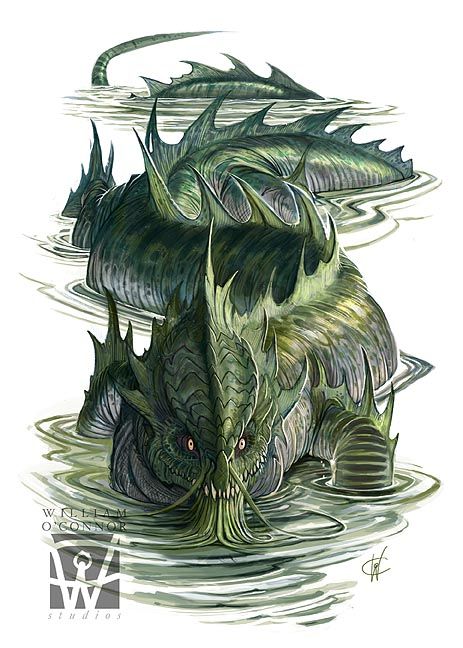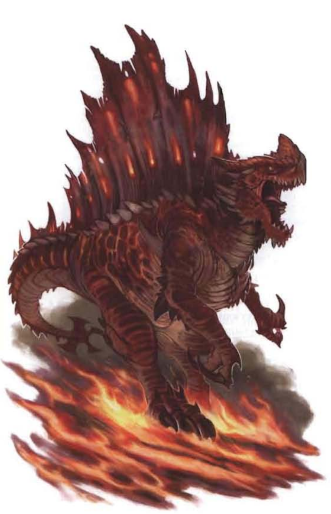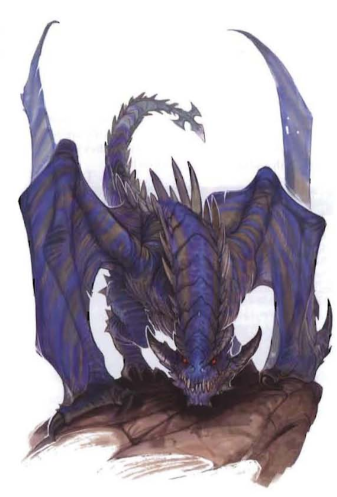Let's Read the Dark Sun Creature Catalog: Drake
This post is part of a series! Click here to see the rest.
The Lore
Athas only has one dragon: The Dragon of Tyr. He’s the setting’s main bad guy, over and above the Sorcerer-Kings. As such, he’s immensely powerful, intelligent, and evil. Prime Final Boss material!
However, you might not want to wait until your PCs are level 30 demigods before they can fight a nasty giant lizard with elemental powers. That’s where Drakes come in.
Athas has a lot of things that would be called drakes in standard 4e, but here the name refers to something else entirely. The things Athasians call “Drakes” are, essentially, nonsapient dragons. They fulfill many of a dragon’s narrative functions. They’re big and tough enemies that make splendid boss fights for high-Paragon or low-Epic parties. There are several types associated with different elements. They lair in areas dominated by their associated element and possess psychic powers that let them summon and control orbs of that element from the Elemental Chaos. They even have a hoarding instinct!
The roles they don’t fulfill are those of being a Machiavellian plotter or a big player in regional politics, which are things you’d expect a powerful enough dragon to be. They’re animals, not people. A text box informs us drakes were written this way because the Dark Sun setting is very geographically limited, and has a relatively small number of movers-and-shakers who are all accounted for. Adding an arbitrary number of traditional sapient epic dragons to this mix would wreck the setting’s delicate equilibrium, and that’s a job for the PCs.
Another consequence of drakes not being sapient is that there’s no guarantee their hoards will be valuable. There might be some good loot there, but it’s going to be mixed with a mountain of trinkets and souvenirs that are merely shiny or pretty.
The Numbers
All drakes presented here are Huge Elemental Beasts with the Reptile tag, and a tag corresponding to their associated element. They all have a Bite and a Claw that act as basic attacks, and the signature Drake’s Fury power that lets them spend a single action to use two Claws against one target and a Bite against a different target.
Their elemental orb powers are area attacks that create a hazardous zone in the affected area, but their exact powers vary with each stat block. They always have a Bloodied Response reaction that lets them immediately rechage and use an elemental power when first bloodied.
The same text box that discusses why drakes are nonsapient tells us we can take any dragon from other books and add them as drakes in Athas by declaring them nonsapient. Good candidates include brown, gray and red dragons from the chromatics; adamantine, iron, and orium dragons from the metallics; and any of the catastrophic dragons. You might want to change the appearance of the metallics too, since their default coloration stands out too much.
Water Drake

Water drakes like to lair in oases. A possible sign of their presence is the total absence of the small animals that usually live in such an environment. If you find such a place, you should either keep moving or be very, very sneaky when filling your waterskin.
This crocodile-looking beast is a Level 18 Solo Controller with 680 HP. It has Resist 10 Cold, a ground speed of 8, and a swim speed of 12. It’s Aquatic, meaning it can breathe underwater and gets +2 to attacks against non-aquatic creatures in underwater combat.
The drake’s elemental attack is an Orb of Elemental Water, which is a fireball-sized area attack (area 2 within 10, recharge 5+). It comes in two versions:
-
The boiling orb deals fire damage despite being made of water, and creates a damaging zone that lasts for the rest of the encounter or until the drake uses another boiling orb.
-
The ice orb deals no immediate damage, but inflicts ongoing 20 cold damage and restrains (save ends both). It creates a zone that repeats the orb’s attack against any creatures start their turn in the zone and are not restrained. Again, this lasts until the end of the encounter or until the drake uses another ice orb.
Yes, this means the drake can have both a boiling and a frozen zone in place simultaneously, though I’d rule they can’t overlap.
The drake’s other power is Psionic Clone (minor action, recharge 4+), which lets it create a duplicate of itself on a solid or liquid adjacent space in the map. The copy can acts independently and can take a full turn on an initiative count 10 lower than the original’s. It has all the original’s stats and powers with the following exceptions: it only has 1 HP; and it shares the original’s recharge roll for its powers instead of having its own. If the original has any spent powers when it uses this power, the copy’s powers will also start out spent.
The water drake’s Bloodied Response recharges both the Orb and Psionic Clone, letting the drake use both as a free action right then and there. Double the orbs, double the fun.
Fire Drake

The flavor text here has a fire drake living inside an active volcano and worshipped as a god by a halfling tribe, who try to sacrifice a human to it only to be eaten along with the intended victim. Cliches aside, this shows us you can find fire drakes in volcanos and other such places.
Fire drakes are Level 20 Elite Lurkers with 298 HP, a Speed of 9, and Resist 15 Fire.
The drake’s bite does standard damage for its level. The claw is a little weaker but grabs on a hit. Drake’s Fury works as normal.
The creature’s Orb of Elemental Fire (recharge 5+) is an Area Burst 1 within 10 that deals fire damage and creates a damaging fire zone that lasts until the end of the encounter or until the drake casts another orb. While it waits for the power to recharge, it can use minor actions to move the existing magma zone 4 squares. The drake’s Bloodied Response recharges this orb and lets the beast use it immediately.
The fire drake’s last power is not elemental: it’s Living Shield, an opportunity action that lets the beast use a grabbed victim as a shield if anyone other than that victim damages it. This makes the victim take half of the attack’s damage, with the other half still affecting the drake.
There’s nothing terribly lurkery about the fire drake. With that grab and the mobile zone, you could have made it a controller instead.
Air Drake

Air drakes live in tall mountains and canyons. They love to hunt animals and people who try to walk the precarious passes of these places, knocking them down with their wind powers and devouring the tenderized remains. They’re Level 22 Elite Skirmishers with 404 HP, a ground speed of 8, and a flight speed of 10.
These creatures deal extra damage when they have CA on an enemy, and this bonus increases when they’re bloodied. Their physical attacks are otherwise pretty standard for a drake.
Their Orb of Elemental Air has a wider radius than usual (area burst 3 within 10), and deals untyped damage on a hit. On a hit it also slides the targets 5 squares, and creates the usual damaging zone. The zone cannot be moved, but slides targets 3 squares when it damages them. This recharges when the drake is first bloodied, but it has to be used during the drake’s actions after this.
When pressured, the drake can use Wind Veil as a minor action (recharge 4+). This lets it shift its speed and gain concealment against non-adjacent enemies until the end of its next turn. Bloodied Response recharges this, and lets the creature use it immediately.
It felt odd for Bloodied Response to be such a defensive power here… but then I saw that it’s because the drake can use Control the Wind as a reaction when damaged. This is a Close Burst 5 vs. AC that deals the same damage as the bite to the triggering enemy, and lets the monster slide the target 3 squares. Exceptionally, this slide can be vertical, which means the target will take a bit of fall damage when it falls back to the ground… or a lot of fall damage if tossed diagonally into a chasm. A merciful GM could probably still allow the usual save vs. hazardous terrain to let the victim cling to an edge before being tossed.
Earth Drake

A spicy bullette with earth control powers. Earth Drakes are Level 24 Elite Controllers with 456 HP, a ground speed of 8, and a burrow speed of 6.
Their physical attaks work as usual. Their Orb of Elemental Earth is an Area 1 within 10 attack vs. Fortitude. It damages and restrains (save ends) on a hit, deals half damage on a miss.
The resulting zone is difficult terrain, and the drake can use minor actions to make secondary attacks against anyone inside. This deals a tiny bit of physical damage and knocks the target prone. This is what Bloodied Response recharges, but it’s not the only thing that happens when the earth drake is bloodied.
You see, when that happens the drake Expands. It goes from Huge to Gargantuan, pushing any targets that were adjacent to it out of its new occupied space. While this lasts (until the end of the drake’s next turn), the drake’s melee reach improves from 3 to 4, it gains +2 to AC, and anyone hit by its attacks is immobilized.
When someone damages the drake it can use Immovable Stone as a reaction, ignoring up to 4 squares of forced movement and using its bite against the attacker.
Encounter and Final Impressions
Since Athasian Drakes lack sapience, it’s harder to justify them being accompanied by minions. However, all but the Water Drake are elites, which means it’s very easy to set up an encounter against a mated pair of them. It might also be possible to add elementals of an appropriate level to any drake encounter as extra minions or regulars. The beasts wouldn’t be interested in eating them.
Overall I like their mechanics. Taking one of these drakes and turning them into a sapient dragon for outside of Dark Sun is as easy as taking a foreign dragon and turning it into an Athasian Drake.